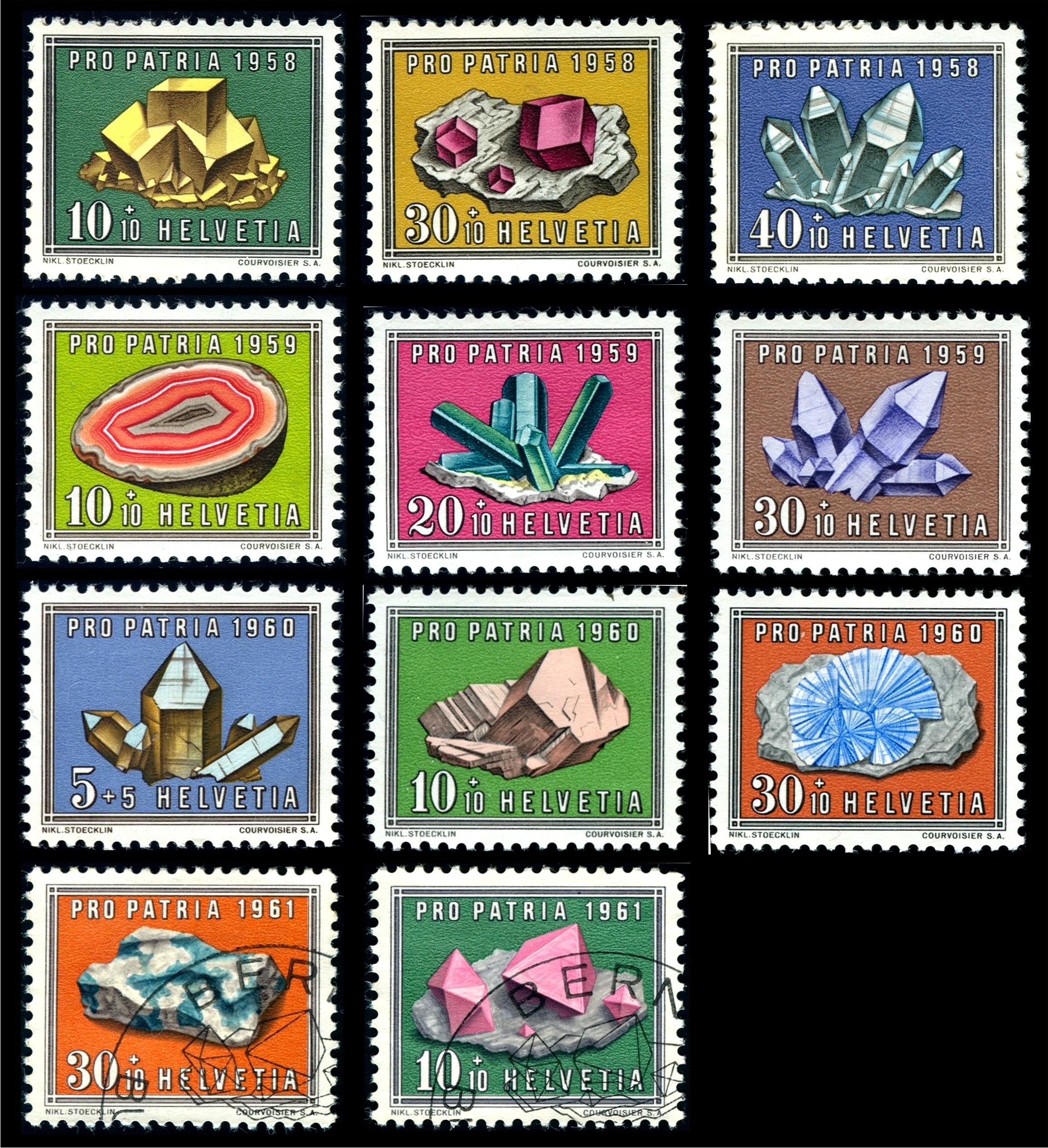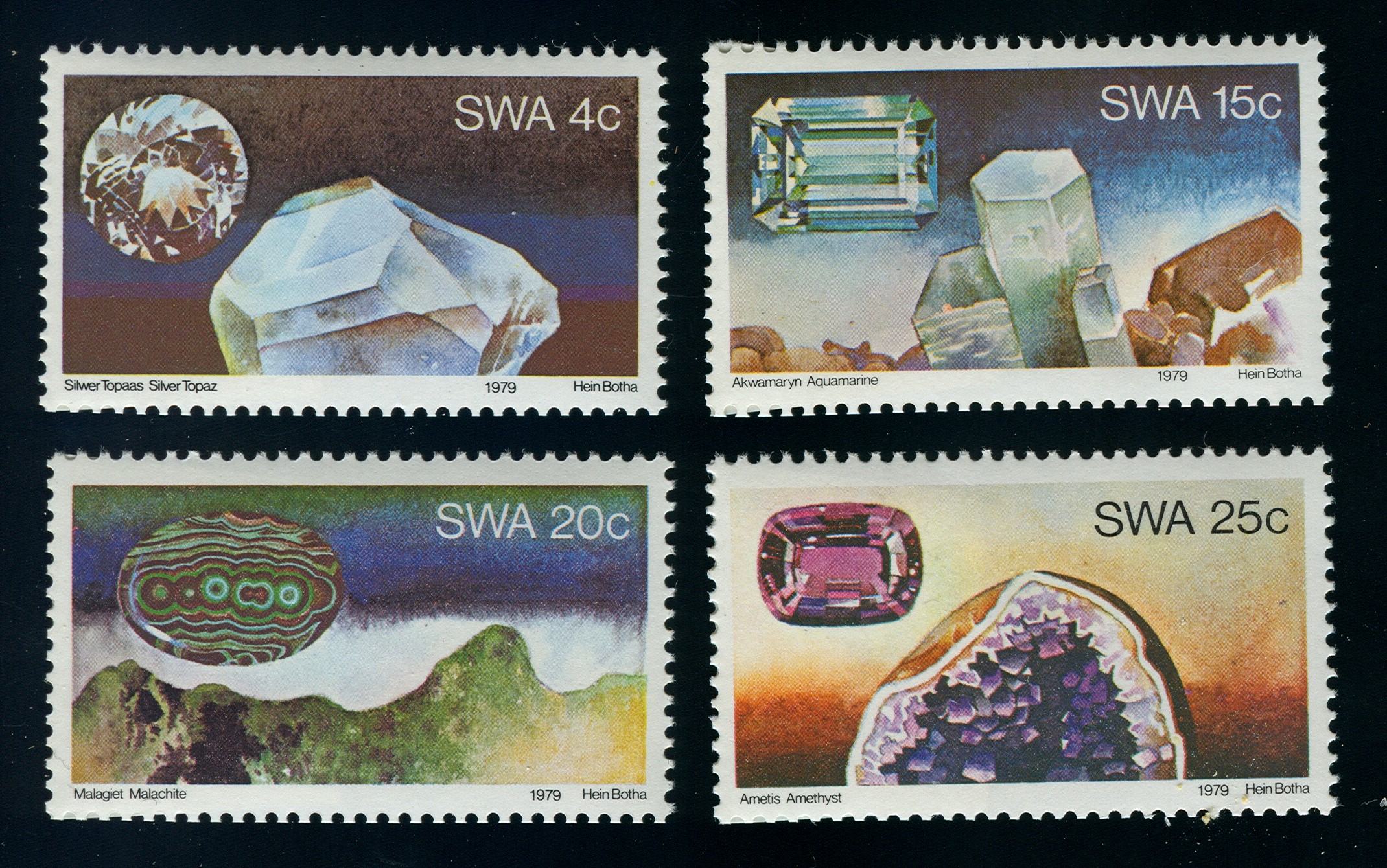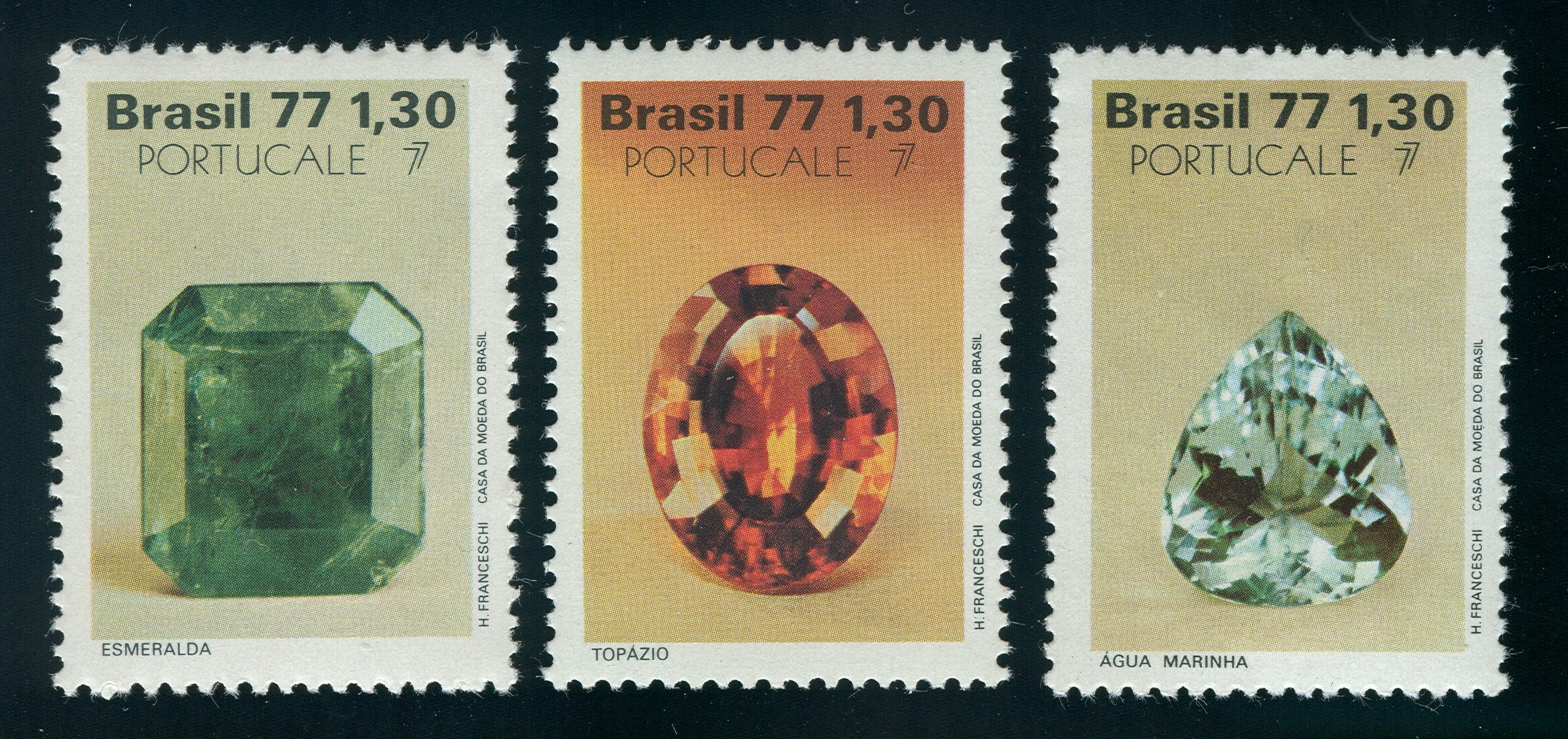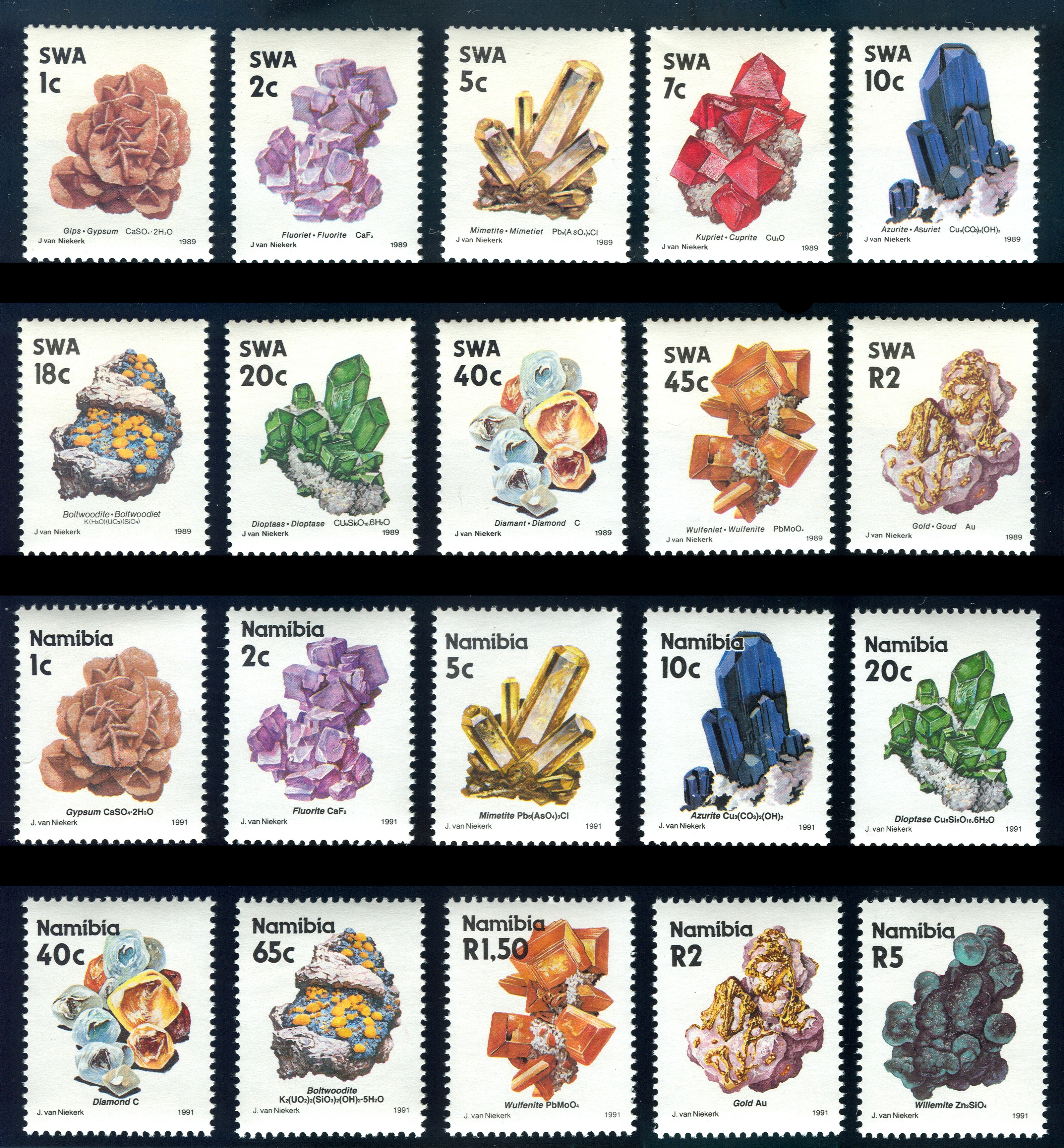Most people would agree that minerals represent some of the most beautiful natural objects known to mankind, especially in the form of precious and semi-precious gemstones. It is hardly surprising, therefore, that they are often illustrated on stamps. Examples are the fine crystalline forms represented as coloured etchings in the French 1986 issue [France, 1986] (Stamps will be referenced in the form [Country, Date], with a reference list at the end of this article). (Fig.1) and the stylized simplicity of the mineral stamps that were part of the Swiss Pro Patria series, issued annually between 1958 and 1961 [Switzerland, 1958-1961] (Fig. 2). I aim in this article to introduce the beautiful world of mineral illustrations on stamps. The article cannot be comprehensive because of the very large number of minerals and stamps concerned, but it will introduce the range of minerals depicted on stamps, then look in some greater detail at several sets from France, Southern Africa and East Germany.

Fig. 1. French 1986 issue of four stamps, depicting typical French minerals: marcassite, quartz, calcite, fluorite.
Minerals become the subject of sets of stamps for many reasons. In many cases, it is part of an attempt by the particular national post office to depict the whole of the natural history of their country in stamp form. The 1986 French issue was an example of this, following sets of stamps that had already portrayed insects, flowers, trees and birds. We also find that certain countries have produced several sets of stamps to mark the importance to their economy of mining particular minerals. Many african states depend upon minerals for much of their wealth and economic power, explaining why, for instance, Sierra Leone issued over 35 stamps on the subject of diamonds between 1965 and 1978 [e.g., Sierra Leone, 1970], and why over 77% of mineral stamps come from countries with major mining interests. Countries with traditional links with the history of the study of geology and mining also produce mineral stamps. These are usually European countries with a long record of the study of the Earth, such as Germany and Switzerland. Curiously enough, though, despite its fine tradition of geological observation and research, the United Kingdom has never produced a stamp depicting rocks or minerals.

Fig. 2. Selected stamps from the four issues of Swiss Pro Patria stamps issued between 1958 and 1961. 1958: pyrites, garnet, quartz. 1959: agate, verdelite tourmaline, amethyst. 1960: smoky quartz, orthoclase, azurite. 1961: fluorite/cuprite, lazurite.
Small illustrations of coloured stones
The range of minerals depicted on stamps is very large. It is difficult to give an absolute figure, but I have at least 200 mineral types recorded, ranging from diamond, which not surprisingly represents the single most depicted mineral on stamps (over 100 separate issues), to boltwoodite [South West Africa, 1989], euxenite [Mozambique, 1979] and aurichalcite [Congo, 1970], each of which has been the subject of only a single stamp. The various forms of quartz are also well represented (over 76 separate issues), including the popular amethyst [e.g. New Zealand, 1982], citrine [Botswana, 1974], agate [Morocco, 1975] and opal [Australia, 1973].
The most popular subjects, apart from diamond and quartz, are other precious and semi-precious gems such as sapphire [USSR, 1971] and ruby [Sri Lanka, 1976], both of which are gem-quality forms of corundum, Al2O3. Other gemstone-quality minerals include emerald [Brazil, 1977], a form of beryl (Be3Al2(Si6O18)) which is deep green owing to the presence of traces of chromium, and aquamarine [South West Africa, 1979] (Fig. 3a), a beryl which is pale blue to pale green because of the presence of ferrous iron. Other colours of gem-quality beryl are also represented on stamps, particularly the yellow/brown heliodor [South West Africa, 1961], pink morganite [Rhodesia, 1978; Zimbabwe, 1980] (Fig. 4) and a deep violet red beryl [Mozambique, 1971]. The colours of these beryls derive from the presence of either aluminium being substituted with ferric iron, caesium/other alkali metals, or manganese, respectively.

Fig. 3. South West African 1979 issue of four stamps, showing coloured gemstones in their native and cut form: topaz, aquamarine, malachite, amethyst.
Garnets, topaz and tourmaline are three other gemstones popular on stamps. Garnets are complex aluminium silicates, the complex mix of metal elements from which they are formed leading to a wide variety of different colour types, including red, green and pink. The most commonly found on stamps is pyrope garnet [Rhodesia, 1978; Zimbabwe, 1980] (Fig. 4). This is a magnesium-rich garnet, blood-red in colour, and most commonly used in jewelry. There is also a pinkish-to-pale-violet version of garnet called rhodolite [Kenya, 1977]. In the same set of stamps, Kenya also issued a green grossular garnet which is calcium rich. Topaz is an aluminium fluosilicate (Al2(F,OH)2(SiO4)) that is usually colourless, but can vary from pale orange-yellow to brownish orange, and occasionally blue. Stamps have covered the whole spectrum of colour possibilities, with colourless versions from the USSR [1963], pale orange from East Germany [1974], brownish orange from Brazil [1977] (Fig. 5) and blue versions in the related sets from Rhodesia [1978] and Zimbabwe [1980] (Fig. 4). Tourmaline is a complex aluminium, iron, lithium boro-silicate. It is an unusual mineral, crystallizing rhombohedrally, forming characteristic long crystals with a bulging triangular cross-section. It comes in various colours which have individual names - verdelite (pale green), indicolite (pale blue), rubellite (pale pink) and achroite (colourless) - but most often exhibits a colour change either along its length or in concentric radial zones. Stamps have been issued depicting verdelite [Kenya, 1977] and rubellite [Mozambique, 1979], as well as the multi-coloured form [USA, 1974].

Fig. 4. The five-value Rhodesia, 1978, and Zimbabwe, 1980, stamp issues, showing the changes brought about by independence. Both sets: morganite, amethyst, garnet, citrine, blue topaz.
Not surprisingly, the crystalline form of various oxides and ores of metals, as well as metals in their native state, also form a large group of stamp issues. There are too many to list completely. Stamps illustrate some rather rare ores and oxides such as lengenbachite [North Korea, 1986], a complex metal sulphide found in cavities of crystalline dolomite associated with pyrite and other rare sulphosalts at Lengenbach in the Binnental Valais, Switzerland. Other rare oxides include wolframite [China, 1982], a manganese and iron tungstanate ((Fe,Mn)WO4); wulfenite [South West Africa, 1989] (Fig. 6), a very fragile orange yellow lead molybdate found in desert zones (PbMoO4); cinnabar [China, 1982], a seldom crystallized mercury sulphide (HgS), whose largest mine is the Almaden near Ciudad Real in Spain and has been working since Roman times; and bournonite [Zaire, 1983], also called endellionite, from its original Cornish location, where its orthorhombic crystallization and frequent twining conspire together to produce crosses and wheel-shaped formations with a brilliant grey metallic lustre. This mineral was also called "wheel ore" by the original Cornish miners.

Fig. 5. Brazilian 1977 issue of three stamps, showing cut gemstones from Brazil: topaz, aquamarine, emerald.
More common ores are also well represented-for example, bauxite [Greece, 1980], a hydrous aluminium oxide (Al2O3.2H2O), a major aluminium ore. Originally named after Les Baux in Provence, France, it is formed by the weathering of rocks with high alumina content in tropical climates. Other ores include chromite [Greece, 1980], the only ore of chromium (FeCr2O4). Chromite crystallizes in the cubic system, but is much more commonly found in the massive form used in stamp illustrations. Finally, cassiterite [Zaire, 1983] is tin oxide (SnO2), and the main, if not only, mineral containing this element. When pure, it is colourless, but as with sphalerite, its colour depends upon the iron content, varying fromlight brown to opaque black. It tends to be concentrated in alluvial deposits because of the combination of its hardness and high density. There is a small range of metals found in the Earth as minerals. Such deposits of metal are termed "in their native state". Metals which are found in this way include gold, silver, copper, arsenic, iron, tellurium, antimony, platinum, mercury and bismuth. The few that have been commemorated on stamps are either precious or of economic value. For example, in 1932, Colombia issued two stamps depicting gold [Colombia, 1932]. These are particularly interesting as they represent the oldest stamps portraying minerals known to exist. Native silver is represented by just one stamp issue [East Germany, 1969], while native copper is represented by stamps from at least five countries [e.g. Hungary, 1969].

Fig. 6. The ten mineral definitive stamps from the 15- stamp issues for South West Africa (1989), before independence, and Namibia (1991), after independence. Note change to equation in boltwoodite. South West Africa (1989): gypsum, fluorite, mimetite, cuprite, azurite, boltwoodite, dioptase, diamond, wulfenite, gold. Namibia: gypsum, fluorite, mimetite, azurite, dioptase, diamond, boltwoodite, wulfenite, gold, willemite.
France - natural history
13 September 1986 was an unusual date for French mineral and stamp collectors. For the first time in France, a set of four stamps depicting typical French minerals had been issued (Fig. 1). The issue was not intended to commemorate any particular occasion, but rather to add to the already rich series of stamp sets issued by the French postal service on the subject of French natural history. The engraver, Pierre Forget, had selected specimens from the mineralogical collection of the Pierre et Marie Curie University in Paris to match two criteria: first, that they should be of French origin and, secondly, that they, should be recognizable as the mineral type they represented around the world. The stamps were prepared as gravure in intaglio on copper, and subsequently recess printed. An exhibition, entitled 'The World of Minerals through Postage Stamps', was arranged on the first day of issue at the Paris University Mineral Collection. It contained more than 400 stamps and over 1175 philatelic references. Such was the interest in the exhibition that a thematic catalogue was produced in book form. This is the only significant reference work on stamps depicting minerals.
Southern Africa-states of independence
As I have already mentioned, countries whose economic wealth largely depends on the exploitation of mineral resources often produce stamps depicting the minerals which have particular importance to their mining activities. The southern African countries all fall into this category. Southern Africa has also been particularly politically volatile in recent years, and stamps are very much affected by changes in the political structure or government of a country. This is because, despite their seemingly insignificant size, by being printed with the name of the country and some monetary value, stamps are a symbol of the sovereignty and government of the country. Furthermore, stamps are very widely distributed, both within the country and internationally, acting as tiny propagandists proclaiming the status quo. Clearly, after any large-scale change in government, whether peaceful or otherwise, one of the first priorities is to redesign the stamps with, wherever relevant, a new country name and new currency. This has to be done so swiftly that old sets of stamps are often used with overprints, or there is a new printing of stamps with the same designs but using new text. There are several examples of this in connection with mineral stamps in southern Africa.
A particularly beautiful and unusual set of stamps was issued in 1989 by South West Africa [South West Africa, 1989] (Fig. 6). It is unusual in several respects. The first is historical; a few months after their issue the Republic of South West Africa, which had previously been controlled by South Africa, declared multilateral independence and became Namibia. Clearly, it could not keep the stamps with the old name, but since the stamps were only a few months old, most of the designs were kept, with the name changed [Namibia, 1991] (Fig. 6). Both sets have an unusually high number of stamps. The SWA set contained 15 stamps, of which ten were fine depictions of minerals (gypsum, fluorite, mimetite, cuprite, azurite, boltwoodite, dioptase, diamond, wulfenite, gold) and five were illustrations of different types of mining. The succeeding Namibian set also contained ten minerals and five mining techniques with the same illustrations except that the 7-cent cuprite stamp was replaced with a 5-rand willemite stamp utilizing a spare illustration that had been prepared for the original 1989 issue. Both sets are also unusual in that the minerals were not only named, but the chemical equation of the mineral was also included. Unfortunately, there is a mistake in the chemical equation of one of the stamps from the SWA set. Boltwoodite is a complex potassium uranium silicate. The original 18ct boltwoodite stamp from the 1989 SWA set had a mistaken chemical equation 'K(H3O)(UO2)(SiO4)'. The error was noted, and the printers, J. van Niekerk, instructed to print a correct stamp. In 1990, the corrected 18ct boltwoodite stamp was issued with the correct chemical equation, (K2(UO2)(SiO3)(OH)2.5H2O) [South West Africa, 1990]. Unfortunately, this was only a few short months from independence, and the corrected 18ct stamp is correspondingly rare. The correction, however, was continued onto the 65ct boltwoodite stamp in the 1991 Namibian issue. Unfortunately for the collector, esoteric mistakes, common to a whole set of stamps like this, do not increase their collectability or value. The fact that the SWA set, and especially the corrected 18ct boltwoodite stamp, was only available for a short period, makes it relatively rare, and consequently of greater value.
The reissue of stamps when a country changes its name or becomes independent is not such a rare occurrence. In 1978, Rhodesia brought out a set of five stamps depicting gemstones (morganite, amethyst, garnet, citrine, blue topaz) [Rhodesia, 1978] (Fig. 4). Soon afterwards, Rhodesia became independent of the UK and was renamed Zimbabwe. The gemstone set of stamps was reissued using the same illustrations, only changing the name of the country and repositioning the value, resulting in an improved overall design with the same illustration [Zimbabwe, 1980] (Fig. 4).

Fig. 7. The Ghana 1965 4d diamond definitive stamp, and the same design overprinted to become the Ghana 1965 4p diamond definitive stamp for the new currency.
Another mineral postage stamp that bears the mark of independence comes from Mozambique. In 1971, Mozambique issued an unusual looking diamond-shaped stamp of verdelite (the green form of tourmaline) on a mauve background [Mozambique, 1971]. It was reissued four years later in 1975 bearing the overprint 'Independencia 25/06/75'. [Mozambique, 1975], to mark the independence of Mozambique.
Reissues of stamps also take place for other reasons. In 1959, Ghana produced a 4d stamp depicting a cut diamond above a diamond mine [Ghana, 1959] (Fig. 7). In 1965, the UK government decreed a change of currency in Ghana. The old 4d stamp was overprinted with the words 'Ghana New Currency, 26th July 1965' and reissued [Ghana, 1965] (Fig. 7).
East Germany - minerals and mining history
East Germany produced several sets of well designed stamps on minerals and mining as a result of its historical connection with the early development of modern mining that occurred in the ancient Dukedom of Saxony. It was here that the first steps were taken to develop mining as a modern technology, and geology as a systematic study of Earth materials. In the late fifteenth and early sixteenth centuries, there was an explosion in the rate of silver mining in the Erzgebirge, mining that stimulated the formation of the new towns of Freiberg, St Joachimstahl and Chemnitz. Georgius Agricola (1494-1555) was the miner and technologist from the area of St Joachimstahl and Chemnitz who is widely called the Father of Mineralogy. In 1546, Agricola published De Natura Fossilium, which, despite its title, was primarily a treatise on mineralogy but also touched on petrology and palaeontology. It was in this work that Agricola reviewed the classifications of minerals due to Aristotle (384-322 BC), Avicenna (about 1021 AD) and Albertus Magnus (about 1260), and proposed one of his own. In 1557, De Re Metallica was published, which described the contemporary mining technology of mid-European mining engineers, and was set to become a standard work of mining for over four centuries.
It was from the Erzgebirge of Agricola that the 'German Miners' came with their skills to the England of Elizabeth I, two or three centuries before James Hutton published his Theory of the Earth (1788), William Smith published his studies of the strata of England, Wales and part of Scotland (1815), and Charles Lyell wrote The Principles of Geology (1830), and it was here that the Freiberg Bergakademie was established in 1765. The Freiberg school was to become one of the most famous teaching centres for mining and mineralogy in the world under the guidance of A. G. Werner. Werner stayed in his native land, but his pupils travelled widely and applied their learning in all parts of the world. Among them were such men as von Buch, Cotta, Lomonosov and Humbolt, as well as Goethe and Greenough, one of the founders and the first President of the Geological Society of London (1807). The Erzgebirge well deserves to be called the 'Cradle of Geology'.

Fig. 8. The East German 1965 issue of four stamps to commemorate the foundation of the Freiberg Bergakademie: smelting, ore winning, proustite, sulphur.
In 1965, the two hundredth anniversary of the Bergakademie was celebrated by East Germany by the issue of four stamps based on woodcuts from De Re Metallica [East Germany, 1965] (Fig. 8). The stamps illustrate mining, smelting and two minerals - crystals of sulphur with quartz, and of proustite, a silver arseno-sulphide ore (Ag2AsS3) which is also known as Saxon Silver. Proustite has a deep redcurrant colour that is unusual among metallic minerals, and a high refractive index responsible for its matchless brilliance, making it a popular collectors' specimen. In 1969, the first six of a second set of mineral stamps was issued depicting minerals from the Harz region [East Germany, 1969]. The set includes fluorite (CaF2), galena (PbS), smoky quartz, calcite (CaCO3), native silver and erythrite, a deep carmine-coloured hydrous cobalt arseniate (Co3(AsO4)2·8H2O). Fluorite, which is also known as 'miners' fluorspar., is often associated with metallic ores in veins, and was put to good use as a fusing agent in metallurgy. This mineral is particularly appreciated by collectors; its well-shaped cubic crystals can be up to one metre in size and show various colours ranging through violet, pink, blue, green and yellow It can be colourless or black in uranium-bearing veins.

Fig. 9. The East German 1972 issue of six stamps, showing minerals from the Freiberg Bergakademie collection: gypsum, zinnwaldite, malachite, amethyst, halite, proustite.
The second set was completed in 1972, with the issue of a further six stamps [East Germany, 1972] (Fig. 9) illustrating gypsum (Ca(SO4).2H2O), zinnwaldite, malachite (Cu2(CO3)(OH)2), amethyst, halite (NaCl) and proustite (Fig. 8). Gypsum, a hydrous calcium sulphate, crystallizes to produce monoclinic crystals that can be up to 3 m long. An alternative form is the "desert rose", which consists of randomly intersecting subcircular plates of sandy brown colour to form a complex mass. This form is appreciated by mineral collectors and has been the subject of several stamp issues [e.g. South West Africa, 1989] (Fig. 6). Zinnwaldite is an iron- and lithium-rich mica whose colour varies through white, silvery, nacreous pink, brown and black. It represents one of the most important ores for the production of lithium. The stamps were produced on the occasion of, and to commemorate, an international symposium on the history of geology, held in Freiberg. Only two years later, a further six stamps were issued, this time including jasper (a blend of cryptocrystalline silica and iron oxides), smoky quartz, topaz, amethyst, aquamarine and agate [East Germany, 1974]. All the designs in the 1965, 1969, 1972 and 1974 issues were based on actual specimens from the unrivalled Bergakademie mineral collection. Between 1965 and reunification, East Germany had produced 21 mineral stamps associated in some way with the commemoration of German's contribution to the study of geology over 250 years.
Summary
It is often said that the study of stamps is the most catholic of pastimes, educating the collector in the appreciation of the art of illustration, geography, foreign languages and cultures, and history. I hope this article has shown that the collection of minerals on stamps can also include geology in that list. The illustration of minerals on stamps is yet another way of appreciating what beautiful structures and colours minerals possess.
Reference list
These pages are based on an article by Paul Glover : Minerals on stamps, Paul W.J. Glover, Geology Today, Nov-Dec 1996, 223-229. PDF
Le Monde mineral vu par les timbres/The World of Minerals through Postage Stamps., 1987, J. M. Autissier & N. Bariand, ISBN: 2-950-2340-0-3, 121pp., Atelier JMA, 54 Rue de Billeron, F18200, St-Amand-Montrond. This is written in French and English, profusely illustrated in colour on glossy pages, and lists mineral stamps comprehensively up to 1987. It can be obtained from the publisher, or through Vera Trinder Philately Supplies, London.)
Mineral stamps http://mineralstamps.com/
Keimar stamps http://www.keimarstamps.com/
Postage Stamps -Metallurgy, Art, History by Fathi Habashi http://works.bepress.com/cgi/viewcontent.cgi?article=1070&context=fathi_habashi
Warsaw University Minerals on Stamps page http://www.geo.uw.edu.pl/HOBBY/STAMP/MINERAL/0mineral.htm
Philatelic mineralogy http://stampmin.home.att.net/
Mineral list
Australia, 1973, 5 values: chrysoprase, agate, opal, rhodonite, star sapphire.
Botswana, 1974, 14 values: amethyst, pink agate, quartz, nickeline, moss agate, agate, stilbite, marble, diamond, chrysotile, jasper, moss quartz, citrine, chalcopyrite.
Brazil, 1977, 3 values: topaz, aquamarine, emerald.
China, 1982, 4 values: orpiment, stibnite, cinabar, wolframite.
Columbia, 1932, 2 values: gold, gold.
Congo, 1970, 2 values: aurichalcite, dioptase.
East Germany, 1965, 4 values: smelting, ore winning, proustite, sulphur.
East Germany, 1969, 6 values: erythrite, fluorite, galena, smoky quartz, calcite, native silver.
East Germany, 1972, 6 values: gypsum, zinnwaldite, malachite, amethyst, halite, proustite.
East Germany, 1974, 6 values: banded jasper, quartz, topaz, amethyst, aquamarine, agate.
France, 1986, 4 values: marcassite, quartz, calcite, fluorite.
Ghana, 1959, 1 value: diamond.
Ghana, 1965, 1 value: diamond.
Greece, 1980, 7 values: chrysotile, gypsum, native copper, barite, chromite, pyrites/sphalerite/galena, bauxite.
Hungary, 1969, 8 values: calcite/greenokite/sphalerite, quartz, native copper, cuprite, and 4 fossils.
Kenya, 1977, 15 values: gypsum, trona, kyanite, amazonite, galena, silicified wood, fluorite, amethyst, agate, tourmaline, aquamarine, rhodolite, sapphire, ruby, green grossular garnet.
Morocco, 1975, 2 values: aragonite, agate.
Mozambique, 1971, 6 values: stibiotantalite, beryl, tantalocolumbite, verdelite tourmaline, zircon, silicified wood.
Mozambique, 1975, 2 values: verdelite tourmaline (overprint), silicified wood.
Mozambique, 1979, 6 values: quartz, beryl, magnetite, tourmaline, euxenite, fluorite.
Namibia, 1991, 15 values: gypsum, fluorite, mimetite, azurite, dioptase, diamond, boltwoodite, wulfenite, gold, willemite, and 5 mining scenes.
New Zealand, 1982, 6 values: nephrite, agate, pyrites, amethyst, carnelian, native sulphur.
North Korea, 1986, 3 values: lengenbergite, rhodocrosite, anabergite.
Rhodesia, 1978, 5 values: morganite, amethyst, garnet, citrine, blue topaz.
Sierra Leone, 1970, 20 values: all diamonds.
South West Africa, 1961, 4 values: diamond, topaz, tourmaline, heliodor.
South West Africa, 1979, 4 values: topaz, aquamarine, malachite, amethyst.
South West Africa, 1989, 15 values: gypsum, fluorite, mimetite, cuprite, azurite, boltwoodite, dioptase, diamond, wulfenite, gold, and 5 mining scenes.
South West Africa, 1990, 1 value: boltwoodite (new chemical equation).
Sri Lanka, 1976, 5 values: sapphire, cat's eye chrysoberyl, star sapphire, ruby, corundums and chrysoberyls.
Switzerland, 1958, 5 values: pyrites, garnet, quartz, ammonite, mother and child.
Switzerland, 1959, 5 values: agate, verdelite tourmaline, amethyst, fossil lizard, world net.
Switzerland, 1960, 5 values: smoky quartz, orthoclase, azurite, fossil shell, owl on tools.
Switzerland, 1961, 5 values: fluorite/cuprite, lazurite, fossil fish, fossil leaf, book.
USA, 1974, 4 values: amethyst, petrified wood, rhodocrosite, tourmaline.
USSR, 1963, 6 values: topaz, jasper, amethyst, emerald, rhodonite, malachite.
USSR, 1971, 3 values: sapphire, Shah diamond, amethyst.
Zaire, 1983, 9 values: malachite, quartz, gold, uranium (pitchblende), bournonite, cassiterite, dioptase, cuprite, diamond.
Zimbabwe, 1980, 5 values: morganite, amethyst, garnet, citrine, blue topaz.